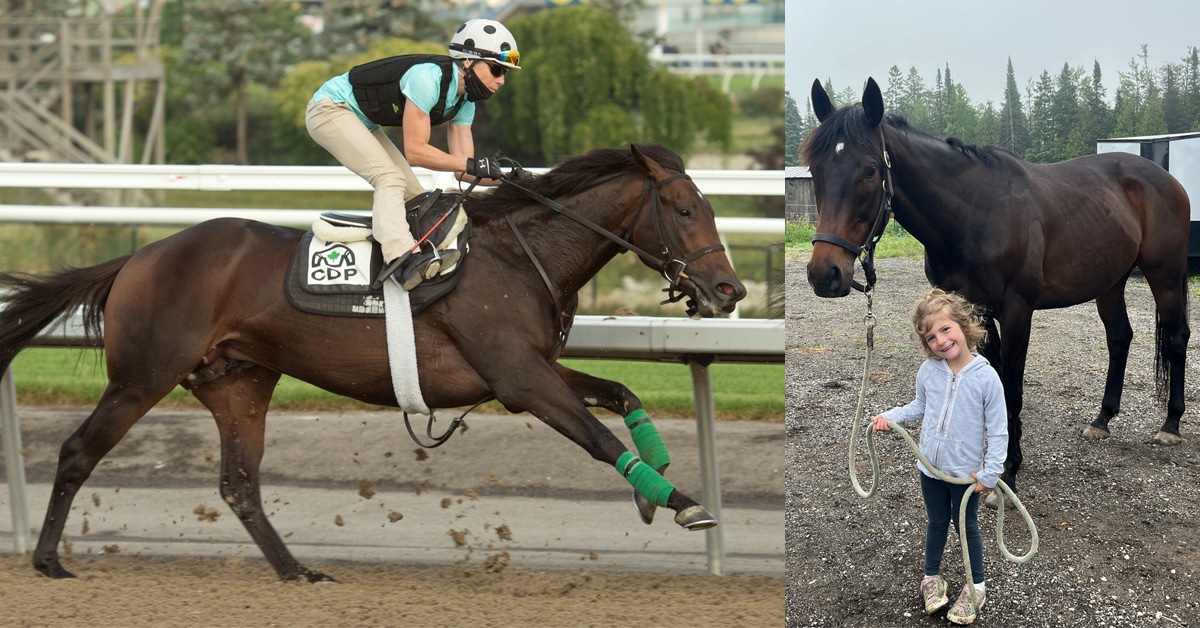A training schedule to bring a horse back to racing fitness will differ depending on how long the horse has been idle. For fitness sake, I’ll divide the horses coming back to the track into two groups: those who have raced as recently as October of the previous year, and those who have not raced since the summer.
Horses who raced in late fall are a bit easier to get racing fit. They reached a fitness level to race last fall that has not completely disappeared come February. Patience plays a bigger role when you are preparing a horse for racing that has been off the track for more than seven months or has never raced.
Many will start training about 50 days before the start of the racing season. Some Canadian farms have a training centre that will put in about 30 days of ‘legging up’ into your horse before they come to the track. If a horse has been galloping inside for a month you can reduce your galloping on the track by 15 days. If they have just been jogging for a couple of weeks, you can cut out about five days off track training.
There is a lot to be said for horses getting in a lot of training on a busy racetrack. There is a nervous tension caused by other horses on the track. Your horse will be keen and eager and that will make his gallops much more beneficial.
In the 50 days, I believe you can get most horses fit to win at 5 furlongs, especially if they are in a race with other horses that have been on the same schedule. But they won’t have the foundation to come back and run well in a 7 furlong race a couple of weeks later. The winter-raced horses have a huge advantage in the longer races early in the meet. To accommodate the returning horses, tracks usually offer abbreviated distances, such as 4 1/2 or 5 furlongs, the first couple of weeks of a new season.
Off the farm, little to no winter exercise
The only thing you don’t want is a horse to come into the track with a big hay belly. If they come in 50 pounds heavier than their ideal racing weight, that is perfect.
To get the horses limbered up and ready to begin building fitness, I like to jog them three or four days, either in the shedrow if the weather is bad or on a track. They will jog for 1 1/2 miles.
After a few days of jogging, they graduate to galloping, also at 1 1/2 miles. You want the horse to be able to handle that distance in just over three and a half minutes without being too winded. The rider should be able to tell whether the work was enough or too much.
I like to see them gallop the one mile in about 2:15 all the way through their training.
In about 20 days I’ll ask a horse for a short breeze at 3 furlongs. I am looking for a 3 furlong workout in 38 or 39 seconds and hopefully they are not winded. If he comes back blowing hard and gulping down water then you have done too much and he doesn’t have enough foundation. In that case you have to take a step back.
For those that pass the initial test, I’ll continue with the 1 1/2 mile gallops every day to build the foundation and then ask for work number two also at 3 furlongs. This will be followed by another 3 furlong prep, a half-mile and then 5 furlongs. The workouts come every five to seven days.
At the outset, I’m not terribly concerned in the times of the workouts. If you can get your horse down to 1:01 for 5 furlongs that is good. It is the gallop out past the wire that will show you how fit he is and how willing he is. Is he doing it well on his own without urging from the rider?
I’ll take horses that have raced before to the starting gate for training in the morning at least once and more times for unraced horses. If I’m preparing a horse to make his season debut in a longer event I’ll stay away from a gate workout as it can get them a little too wound up.
Interestingly, I’ve noticed a trend among conditioners that the distance of their workouts is generally shorter than they used to be. In older days, trainers such as New York-based Allen Jerkens would work their horses the distances they were running; 6 furlongs, 1 mile. Most trainers today go to 5 furlongs and rarely farther as the modern thoroughbred tends to be softer and many won’t last.
By the time my horse has prepped up to 5 furlongs, he should be ready to do well in an early season race at a short distance. But I reiterate that’s not an ideal set-up for a 7 furlong race the second time out. It’s a myth that you can run a horse 5 furlongs first time out and be successful at 7 furlongs the second time. The horses that were off over the winter don’t have a good enough foundation. I believe that you need at least 100 days of training and works to handle 7 furlongs.
The Latest










